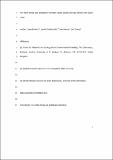Files in this item
Fin whale density and distribution estimation using acoustic bearings derived from sparse arrays
Item metadata
| dc.contributor.author | Harris, Danielle V. | |
| dc.contributor.author | Miksis-Olds, Jennifer L. | |
| dc.contributor.author | Vernon, Julia A. | |
| dc.contributor.author | Thomas, Len | |
| dc.date.accessioned | 2019-03-01T15:30:18Z | |
| dc.date.available | 2019-03-01T15:30:18Z | |
| dc.date.issued | 2018-05 | |
| dc.identifier | 253233401 | |
| dc.identifier | 455d7d83-9884-44ef-bd20-00088999df76 | |
| dc.identifier | 85047240179 | |
| dc.identifier | 000433050700061 | |
| dc.identifier.citation | Harris , D V , Miksis-Olds , J L , Vernon , J A & Thomas , L 2018 , ' Fin whale density and distribution estimation using acoustic bearings derived from sparse arrays ' , Journal of the Acoustical Society of America , vol. 143 , no. 5 , pp. 2980-2993 . https://doi.org/10.1121/1.5031111 | en |
| dc.identifier.issn | 0001-4966 | |
| dc.identifier.other | ORCID: /0000-0002-7436-067X/work/45366204 | |
| dc.identifier.other | ORCID: /0000-0003-1447-1420/work/61370043 | |
| dc.identifier.uri | https://hdl.handle.net/10023/17192 | |
| dc.description | D.V.H. and L.T. were funded by the Office of Naval Research (Grant Nos. N00014-14-1-0394 and N00014-16-1-2364). J.L.M.O. and J.A.V. were funded under Grant Nos. N00014-14-1-0397 and N00014-16-1-2860 also from the Office of Naval Research. | en |
| dc.description.abstract | Passive acoustic monitoring of marine mammals is common, and it is now possible to estimate absolute animal density from acoustic recordings. The most appropriate density estimation method depends on how much detail about animals' locations can be derived from the recordings. Here, a method for estimating cetacean density using acoustic data is presented, where only horizontal bearings to calling animals are estimable. This method also requires knowledge of call signal-to-noise ratios, as well as auxiliary information about call source levels, sound propagation, and call production rates. Results are presented from simulations, and from a pilot study using recordings of fin whale (Balaenoptera physalus) calls from Comprehensive Nuclear-Test-Ban Treaty Organization (CTBTO) hydrophones at Wake Island in the Pacific Ocean. Simulations replicating different animal distributions showed median biases in estimated call density of less than 2%. The estimated average call density during the pilot study period (December 2007-February 2008) was 0.02 calls hr-1 km2 (coefficient of variation, CV: 15%). Using a tentative call production rate, estimated average animal density was 0.54 animals/1000 km2 (CV: 52%). Calling animals showed a varied spatial distribution around the northern hydrophone array, with most detections occurring at bearings between 90 and 180 degrees. | |
| dc.format.extent | 14 | |
| dc.format.extent | 1008626 | |
| dc.language.iso | eng | |
| dc.relation.ispartof | Journal of the Acoustical Society of America | en |
| dc.subject | QH301 Biology | en |
| dc.subject | Arts and Humanities (miscellaneous) | en |
| dc.subject | Acoustics and Ultrasonics | en |
| dc.subject | NDAS | en |
| dc.subject | SDG 14 - Life Below Water | en |
| dc.subject.lcc | QH301 | en |
| dc.title | Fin whale density and distribution estimation using acoustic bearings derived from sparse arrays | en |
| dc.type | Journal article | en |
| dc.contributor.sponsor | Office of Naval Research | en |
| dc.contributor.institution | University of St Andrews. School of Mathematics and Statistics | en |
| dc.contributor.institution | University of St Andrews. Sea Mammal Research Unit | en |
| dc.contributor.institution | University of St Andrews. Centre for Research into Ecological & Environmental Modelling | en |
| dc.contributor.institution | University of St Andrews. Marine Alliance for Science & Technology Scotland | en |
| dc.identifier.doi | 10.1121/1.5031111 | |
| dc.description.status | Peer reviewed | en |
| dc.identifier.grantnumber | N00014-14-1-0394 | en |
This item appears in the following Collection(s)
Items in the St Andrews Research Repository are protected by copyright, with all rights reserved, unless otherwise indicated.

